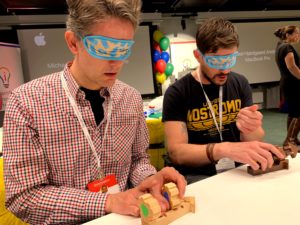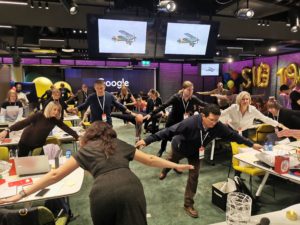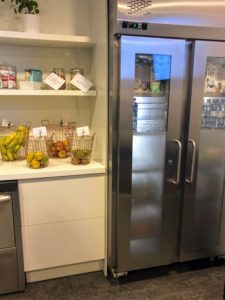Lessons from #GoogleEI #SWE19: Curiosity as a Foundation of Innovation
By Lynne Herr
A second foundation of Google’s Culture of Innovation is curiosity. Tremendous effort goes into creating physical spaces and activities to promote creativity and outside the box thinking.
 At the academy, tables were filled with tubs of creative supplies, from paper and glue sticks to stacks of sticky notes. Lighted message boards with movable letters sat next to stacks of edible lego candies that snapped together. Bean bag and movable benches with pillows complemented the traditional seating areas. Giant balloons and sparkling cohort hashtag letters contributed to a festive, fun work space.
At the academy, tables were filled with tubs of creative supplies, from paper and glue sticks to stacks of sticky notes. Lighted message boards with movable letters sat next to stacks of edible lego candies that snapped together. Bean bag and movable benches with pillows complemented the traditional seating areas. Giant balloons and sparkling cohort hashtag letters contributed to a festive, fun work space.
Sprints – periods of intense content-rich work – were broken up with Sparks – short bursts of inspiration. Initially, sparks were led by coaches and Googlers and including movement such as airplane yoga and karaoke. As the 3-day academy progressed, participants who volunteered to lead sparks led short sessions on everything from blindfolded trust building games to folding origami cranes, from movie making to button making. The only requirement for a spark was a personal passion for the topic. Sparks let us step away from the intense work of sprints to move, create and build relationships. Sprints let us be playful and have fun while giving our brains a break. They energized us for the next sprint.
In addition to large group meeting spaces, Deliberate attention does into designing spaces to promote  employee curiosity throughout the Google offices, encouraging playfulness and collaboration. Each floor features a fully-stocked micro kitchen where Googlers are encouraged to meet colleagues for a snack or beverage and chat – both about work and personal interests. (Side note: It’s no surprise that everything at Google is data driven. And data show that people first choose to eat or drink what it is most accessible, so healthy beverages such as water are behind clear refrigerator windows; juices are behind frosted glass. Fresh organic fruit is in baskets on the counter; chocolate – of course, organic and free trade, is in a drawer.)
employee curiosity throughout the Google offices, encouraging playfulness and collaboration. Each floor features a fully-stocked micro kitchen where Googlers are encouraged to meet colleagues for a snack or beverage and chat – both about work and personal interests. (Side note: It’s no surprise that everything at Google is data driven. And data show that people first choose to eat or drink what it is most accessible, so healthy beverages such as water are behind clear refrigerator windows; juices are behind frosted glass. Fresh organic fruit is in baskets on the counter; chocolate – of course, organic and free trade, is in a drawer.)
 To promote playful curiosity, along with mental and physical health, the Stockholm office features a music recording studio, game rooms, nap rooms, a light therapy room, workout gym and a massage room. Digital posters announced free barista classes for employees who want to up their latte game and promoted a new pub quiz developed by one “Swoogler” to tap into the best work environment for Gen X employees. Even the room names are handled with both creativity and logic. As noted in the bottom right of the sign below, the longer the name, the farther the room is from the sign. The first letter of the room’s name indicates the area of the building where it’s located.
To promote playful curiosity, along with mental and physical health, the Stockholm office features a music recording studio, game rooms, nap rooms, a light therapy room, workout gym and a massage room. Digital posters announced free barista classes for employees who want to up their latte game and promoted a new pub quiz developed by one “Swoogler” to tap into the best work environment for Gen X employees. Even the room names are handled with both creativity and logic. As noted in the bottom right of the sign below, the longer the name, the farther the room is from the sign. The first letter of the room’s name indicates the area of the building where it’s located.
So how might we promote more curiosity and creativity into our schools and workplaces to help create environments that are more open to change, and even seek it out? Here are some ideas:
- Recognize that relationship building is valuable and contributes to a healthy, productive learning and working environment. Encourage cross-department shared breaks.
- Create opportunities for staff to share their personal passions with colleagues.
- Find a way to provide healthy food or beverages to teachers – ideally that they don’t have to pay for or make themselves!
- Make time for colleagues to relax together with no report due at the end
- Find a way to upgrade the broken down sofa in the teacher’s workroom and replace it with flex seating that can be easily rearranged to promote conversation and relaxation.
- Recognize the person inside the employee
What step could you take this week to promote curiosity in your school or workplace? How might you break up normal routine to model outside the box thinking? How might you create space for staff members to share personal passions with colleagues? Or for students to share passions with peers?

